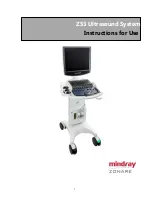
10
19. Make sure that:
• All clips/loops are securely attached
(See Fig. 4 ) and (See Fig. 6 )
• All straps are straight (not twisted)
• The patient lays comfortably in the sling.
20. If an adjustment is needed, lower the patient and
make sure that the weight of the patient is taken up
by the receiving surface before removing the clip/
loop.
21.
If using a clip sling:
adjust the spreader bars
Dynamic Positioning System (DPS), if needed. For
manual DPS, make sure that one caregiver holds
on to the DPS while the other caregiver operates
the lift.
22.
If using loop sling:
lower the patient down onto
the bed and adjust loop lengths.
23. Release the brakes on the lift.
24. Transfer, transport and bathe the patient according
to the lift
IFU
.
In Chair/ Wheelchair (22 steps)
NOTE
Do NOT use a
Hammock Amputee
or a
Double
Amputee Sling with hook and loop fl ap
in chair/
wheelchair. Apply these in bed.
It is recommended that all patients with double
amputees are transferred from a
À
at surface.
1. Place the lift nearby.
2. Apply the brakes on the wheelchair.
3. Check that the stiffeners are completely inside the
stiffener pockets, if any.
4. Stand in front of the patient and lean the patient
forward.
5. Place the sling over the patient’s back and head
with the inside of the sling against the patient. The
sling label is located on the outside. If needed, use
an ArjoHuntleigh sliding sheet/tube for placing the
sling. See respective
Sliding sheet/tube IFU
.
6. Make sure to always be two caregivers present,
when using a sliding sheet for placement of a sling
under the patient’s bottom. See respective
Sliding
sheet/tube IFU
.
7. Make sure that the centre line is aligned with the
patient’s spine and coccyx.
8. Lean the patient back.
9. Place the leg fl ap(s) underneath the patient’s leg(s)/
limb(s).
(See Fig. 13 )
10. If using a loop sling, cross the legs straps. Pull one
strap through the other.
(See Fig. 10 )
11. Make sure that the:
• sling is centred and fl at without creases,
• sling’s head support covers the neck/head area,
• sling pieces are not twisted underneath the
patient and
• if a sling with commode is being used, make
sure the hole is positioned correct
WARNING
To avoid injury, make sure the patient’s
arms are placed inside of the sling.
12. Make sure the patient’s arms are inside the sling.
13. Place the lift in front of the patient. Open the lift
legs, if needed.
14. Apply the brakes on the lift.
WARNING
To avoid injury to the patient, pay close
attention when lowering or adjusting the
spreader bar.
15. Attach the clips/loops.
16. If using a clip sling, adjust the spreader bars DPS,
if needed. If using loop sling, lower the patient
back into the chair/wheelchair and adjust loop
lengths.
17. Slightly lift the patient to create tension in the
sling.
(See Fig. 14 )
WARNING
To avoid the patient from falling, make sure
that the sling attachments are attached
securely before and during the lifting
process.
18. Make sure that:
• All clips/loops are securely attached
(See Fig. 4 ) and (See Fig. 6 )
• All straps are straight (not twisted)
• The patient lays comfortably in the sling.
Continue with the steps on the next page.
Fig. 12
Fig. 13
Fig. 14
EN
Содержание MAA2050M
Страница 18: ...18 ZH...
Страница 19: ...19 IFU ZH...
Страница 20: ...20 6 ArjoHuntleigh 5 IFU IFU 1 2 4 3 5 8 6 7 9 10 11 12 13 14 15 1 1 ZH...
Страница 24: ...24 2 1 2 7 8 24 9 10 11 12 7 8 9 10 11 ZH...
Страница 25: ...25 4 6 22 13 10 14 4 6 12 13 14 ZH...
Страница 26: ...26 32 15 9 16 16 17 18 10 15 16 17 18 ZH...
Страница 27: ...27 19 12 20 17 21 13 22 19 20 21 ZH...
Страница 28: ...28 23 22 23 IFU IFU 7 ZH...
Страница 30: ...30 IFU ArjoHuntleigh on page 22 ZH...
Страница 31: ...31 70 C 158 F 93 42 EEC CE REF XXXXXX X X REF XXXXXXX PES PE PU PA SWL IFU REF ZH...
Страница 92: ...Intentionally left blank...
Страница 93: ...Intentionally left blank...
Страница 94: ...Intentionally left blank...











































